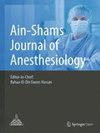A bispectral index guided comparative evaluation of dexmedetomidine as an adjuvant to propofol-based total intravenous anaesthesia in spine surgeries done under motor-evoked potential monitoring
IF 0.5
Q4 ANESTHESIOLOGY
引用次数: 0
Abstract
Abstract Background The anaesthetic agents can affect the quality of motor-evoked potential intraoperatively as they inhibit synaptic transmission. Intravenous anaesthetics suppress motor-evoked potential lesser than inhalational agents, so total intravenous anaesthesia or a combination of intravenous with minimal inhalational anaesthetic supplementation is used when motor-evoked potential is monitored. Motor-evoked potential can get depressed at high doses of propofol required to maintain surgical depth, hence, adjuvant agents like dexmedetomidine that maintain anaesthetic depth without affecting the motor-evoked potential are often required. This study was a prospective non-randomized and comparative study (quasi-experimental) assigned into two groups of 64 each, labelled as the propofol group (group P) and Propofol + dexmedetomidine group (group PD). The primary objective of our study was to compare the total dose reduction of propofol with the addition of dexmedetomidine and their interference with motor-evoked potential readings. The secondary objective was to assess the hemodynamic changes, changes in amplitude and latency of motor-evoked potential, and complications if any. Results The mean total dose of propofol consumed in our study was 502.81 ± 71.01 mg in group propofol( P) and 392.18 ± 59.00 mg in group propofol + dexmedetomidine (PD). Moreover, the mean total dose of propofol (mg) was significantly less used in group PD. Intraoperative hemodynamic stability, no difference in amplitude and latency for motor-evoked potential, and only significant bradycardia in group propofol + dexmedetomidine (PD). Conclusions Dexmedetomidine can be successfully used in propofol-based total intravenous anaesthesia for motor-evoked potential monitoring in spine surgeries, but it is better to maintain stable hemodynamics with a significant reduction of the mean dose of propofol.双谱指数指导比较评价右美托咪定在运动诱发电位监测下辅助异丙酚为基础的脊柱手术全静脉麻醉
摘要背景麻醉药物通过抑制突触传递影响术中运动诱发电位的质量。静脉麻醉药对运动诱发电位的抑制作用小于吸入麻醉药,因此在监测运动诱发电位时,应采用全静脉麻醉或静脉麻醉药加少量吸入麻醉药的联合麻醉。维持手术深度所需的高剂量异丙酚会抑制运动诱发电位,因此,通常需要右美托咪定等佐剂来维持麻醉深度而不影响运动诱发电位。本研究是一项前瞻性、非随机、比较研究(准实验),分为两组,每组64人,分别为丙泊酚组(P组)和丙泊酚+右美托咪定组(PD组)。本研究的主要目的是比较异丙酚与右美托咪定的总剂量减少及其对运动诱发电位读数的干扰。次要目的是评估血流动力学变化,运动诱发电位振幅和潜伏期的变化,以及任何并发症。结果异丙酚组(P组)平均总剂量为502.81±71.01 mg,异丙酚+右美托咪定(PD组)平均总剂量为392.18±59.00 mg。此外,PD组异丙酚的平均总剂量(mg)明显减少。术中血流动力学稳定,运动诱发电位振幅和潜伏期无差异,只有异丙酚+右美托咪定组(PD)有明显的心动过缓。结论右美托咪定可成功应用于脊柱外科手术中异丙酚全静脉麻醉的运动诱发电位监测,但能较好地维持血流动力学稳定,显著降低异丙酚的平均剂量。
本文章由计算机程序翻译,如有差异,请以英文原文为准。
求助全文
约1分钟内获得全文
求助全文

 求助内容:
求助内容: 应助结果提醒方式:
应助结果提醒方式:


